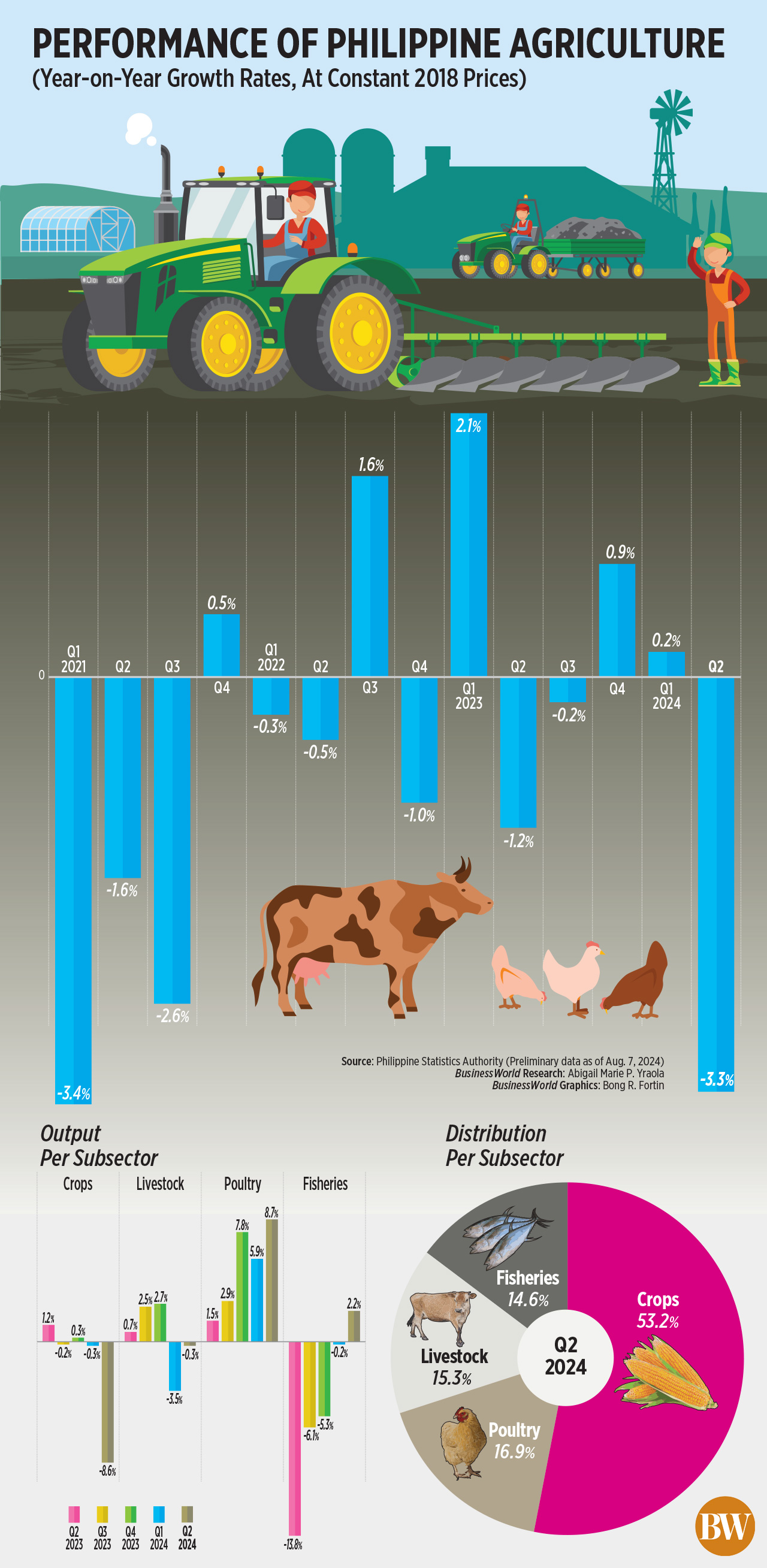By Adrian H. Halili, Reporter
THE PHILIPPINES’ agricultural output fell in the second quarter, as the crops and livestock sector continued to bear the brunt of the El Niño weather phenomenon.
Data from the Philippine Statistics Authority (PSA) showed the value of production in agriculture and fisheries at constant 2018 prices dropped by 3.3% to P413.91 billion in the April-to-June period, worsening from the 1.2% contraction a year earlier.
It was the first decline in agricultural output since the 0.2% drop in the third quarter of 2023, and the biggest drop since the 3.4% contraction in the first quarter of 2021.
 “The reduction was due to the decreases in the value of crops and livestock production. Meanwhile, expansions were recorded in the value of poultry and fisheries production,” the PSA said.
“The reduction was due to the decreases in the value of crops and livestock production. Meanwhile, expansions were recorded in the value of poultry and fisheries production,” the PSA said.
The agriculture sector accounts for about a tenth of the country’s gross domestic product (GDP) and provides about a quarter of all jobs.
The PSA is scheduled to release second-quarter GDP data on Aug. 8.
For the first half, the value of production in agriculture and fisheries slipped by 1.5%, a reversal of the 0.4% growth a year ago.
“The Philippine agriculture sector has demonstrated resilience, bolstered by strategic interventions from the Department of Agriculture (DA), in the face of challenges posed by the adverse impact of El Niño on crop harvest and the stubborn African Swine Fever (ASF) on hog production, particularly during the second quarter,” Agriculture Assistant Secretary and Spokesperson Arnel V. de Mesa said on Wednesday.
Crops production, which accounted for half of the agriculture sector’s total production, slumped by 8.6% year on year in the second quarter. This was a reversal of the 1.2% growth a year ago.
Year to date, crops production dropped by 4.4%, reversing the 1.5% growth a year earlier.
In the second quarter, palay (paddy rice) production declined by 9.5%, while corn plunged by 20.3%.
Also posting double-digit declines in production were sugarcane (-42.3 %), onion (-37.4 %), tomato (-15.6 %), mongo (-14%), and abaca (-12.4%).
Lower output was also seen in rubber (-7.5%), cassava (-7.2%), eggplant (-7%), sweet potato (-5.8%), ampalaya (-5.1%), coconut (-4%), banana (-3.3%), mango (-2.8%), pineapple (-2.7%), tobacco (-1.9%), coffee (-1.87%) and potato (-1%).
Only calamansi (6.4%), cacao (5.9%), and cabbage (2.7%) posted growth in production in the second quarter.
“These drops are the effects of El Niño during the first semester of the year. Crops, particularly rice and corn, either did not survive or suffered yield losses due to lack of water,” Federation of Free Farmers National Manager Raul Q. Montemayor said in a Viber message.
The state weather bureau declared the start of the El Niño weather event in June 2023, bringing below-normal rainfall conditions, dry spells and droughts. El Niño ended in early June, but dry conditions are expected to continue.
Based on the Agriculture department’s final bulletin, farm damage from El Niño hit P15.3 billion, with total crop losses at 784,344 metric tons. Rice and corn were the most affected crops.
“The explanation of (the DA) that the drop was due to delayed planting by some farmers does not seem realistic… So it was not a delay in planting but an inability to plant due to lack of rain,” Mr. Montemayor said.
However, Mr. De Mesa said the DA had supported the agriculture sector during El Niño, earmarking P14.54 billion in financial aid for affected farmers, production support and loans.
LIVESTOCK DROP
Livestock production shrank by 0.3% in the quarter ending June, reversing the 0.7% expansion a year ago. It accounted for 15.3% of the total agricultural output during the April-to-June period.
Data from the PSA showed a drop in the value of production for goat (-2.7%), carabao (-2.4%) and hog (-0.3%). Higher production was seen in dairy (9.7%) and cattle (0.2%).
In the January-to-June period, the value of livestock production slid by 1.9%, a reversal of the 2.4% growth in 2023.
Former Agriculture Secretary William D. Dar said in a text message that the livestock industry, particularly hogs, is still affected by ASF.
“The 0.3% decline (in hogs) is small. Most likely, the market weights of hogs are smaller due to extreme heat, which affected the feed intake and therefore the feed conversion as well,” National Federation of Hog Farmers, Inc. Vice-Chairman Alfred Ng said in a Viber message.
Hogs account for 12.4% of livestock production.
GAINS IN POULTRY, FISHERIES
Poultry output, which accounts for 16.9% of the total agricultural output, jumped by 8.7% in the April-to-June period, an improvement from the 1.5% growth a year ago.
Higher production was seen for chicken eggs (9%), chicken (8.9%), duck (1.3%) and duck eggs (0.8%).
From January to June, the value of poultry production rose by 7.3% from 2.3% a year ago.
Former Agriculture Undersecretary Fermin D. Adriano said the growth in poultry output during the period was due to poultry growers’ improved efforts to curb the spread of bird flu.
“It is easy for poultry production to recover because there are now chicken breeds which can be harvested for less than a month. Old stock affected by bird flu can easily be replenished,” he said in a Viber message.
Mr. Dar said the growth in poultry was driven by the sustained investments of large poultry companies including small- and medium-sized growers.
Meanwhile, fishery production increased by 2.2% in the second quarter, a turnaround from the 13.8% decline a year ago. The subsector made up 14.6% of the total farm output.
Year to date, the value of fishery output inched up by 1.1%, a turnaround from the 7.5% decline last year.
“Fisheries were coming from a very low base, so it was relatively easy for the sector to show an uptick. Maybe the hot weather induced more phytoplankton production,” Mr. Montemayor said.
Gains were seen in skipjack or gulyasan (141.2%), bigeye tuna (94.1%), yellowfin tuna (43.2%), frigate tuna or tulingan (33.7%), P. Vannamei (33.6%), blue crab (7.4%), fimbriated sardines (5.9%) and cavalla or talakitok (4%).
On the other hand, production declined for tiger prawn or sugpo (-40.3%), grouper or lapu-lapu (-34.8%), seaweed (-25.8%), slipmouth or sapsap (-24.7%), big-eyed scad or matangbaka (-22.3%), mudcrab or alimango (-18.3%), round scad or galunggong (-13.6%), squid (-6.8%), tilapia (-6%), milkfish or bangus (-4.6%), threadfin bream or bisugo (-4.4%), and Bali sardinella or tamban (-0.1%).
Mr. Adriano noted that the open fishing season in Philippine waters coupled with better weather contributed to the increase in fishery production.
The DA is targeting 1-2% agricultural growth in 2024, taking into account the effects of the El Niño and La Niña weather events.

